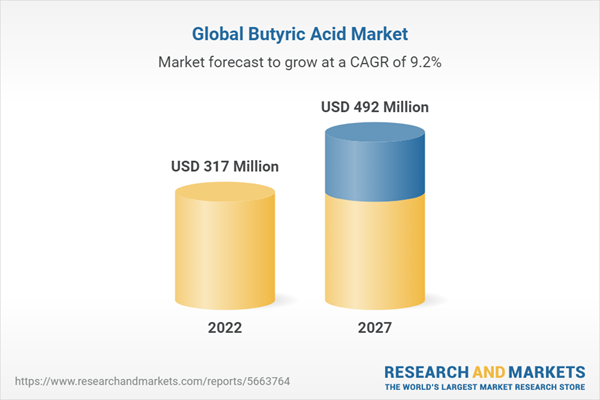The global butyric acid market is projected to grow from USD 317 million in 2022 to USD 492 million by 2027, at a CAGR of 9.2% from 2022 to 2027. The growing animal feed segment, along with the rise in consumption of processed foods, is driving the market.
The synthetic butyric acid segment is projected to grow at the highest CAGR during the forecast period, in terms of volume
Butyric acid is generally produced industrially utilizing chemical synthesis from petrochemical feedstocks. A propylene feedstock is used in chemical synthesis because it is readily available, inexpensive, and majorly used in the petrochemical sector. The easy availability and low cost of manufacturing is expected to drive the segment.
The human dietary supplements segment is projected to grow at the highest CAGR during the forecast period, in terms of volume
Butyric acid is essential for improving digestive health, reducing inflammation, protecting the brain, controlling weight, and preventing cancer. The body's gut bacteria convert foods which one cannot digest into butyrate, which has a variety of positive health effects. Such characteristics of butyric acid is expected to drive the segment.
Asia-Pacific butyric acid market is projected to grow at the highest CAGR during the forecast period, in terms of volume
The Asia-Pacific butyric acid market is projected to grow at the highest CAGR during the forecast period. The countries in the region have substantial growth prospects for the butyric acid market because of factors such as increase in the purchasing power of the population and demand for protein-rich meat diets, thereby driving the butyric acid market in the region.
Research Coverage
The report defines the butyric acid market based on type, end-use, and region. It provides detailed information regarding the major factors influencing the growth of the market, such as drivers, restraints, opportunities, and industry-specific challenges. It strategically profiles key players and comprehensively analyzes their market shares and core competencies as well as tracks and analyzes competitive developments, such as new product launches, expansions, and partnerships undertaken by them in the market.
As a part of qualitative analysis, the research provides a comprehensive review of market drivers, restraints, opportunities, and challenges. It also discusses competitive strategies adopted by varied market players, such as Perstorp Holding AB (Sweden), OQ Chemicals GmbH (Germany), Eastman Chemical Company (US), Palital Feed Additives B.V. (The Netherlands), Tokyo Chemical Industry Co., Ltd. (Japan), Snowco (China), Merck KGaA (Germany), Kemin Industries, Inc. (US), Hefei TNJ Chemical Industry Co., Ltd. (China), Kunshan Odowell Co. Ltd. (China), and others.
Profile break-up of primary participants for the report:
- By Company Type: Tier 1 - 65%, Tier 2 - 20%, and Tier 3 - 15%
- By Designation: C-level Executives - 25%, Directors - 30%, and Others - 45%
- By Region: North America - 20%, Europe - 15%, Asia-Pacific - 55%, South America - 7%, and Middle East & Africa - 3%
Reasons to Buy the Report
The report is expected to help the market leaders/new entrants in the market by providing them the closest approximations of revenue numbers of the butyric acid market and its segments. This report is also expected to help stakeholders obtain an improved understanding of the competitive landscape of the market, gain insights to improve the position of their businesses, and make suitable go-to-market strategies. It also enables stakeholders to understand the pulse of the market and provide them information on key market drivers, restraints, challenges, and opportunities.
Table of Contents
Companies Mentioned
- Central Drug House
- Eastman Chemical Company
- Hefei TNJ Chemical Industry Co. Ltd.
- Kemin Industries, Inc.
- Kunshan Odowell Co. Ltd.
- Merck KGaA
- OQ Chemicals GmbH
- Palital Feed Additives B.V.
- Perstorp
- RX Chemicals
- Sisco Research Laboratories Pvt. Ltd.
- Snowco
- Spectrum Chemical
- Tokyo Chemical Industry Co. Ltd.
- Yufeng International Group Co. Ltd.
Table Information
| Report Attribute | Details |
|---|---|
| No. of Pages | 157 |
| Published | September 2022 |
| Forecast Period | 2022 - 2027 |
| Estimated Market Value ( USD | $ 317 Million |
| Forecasted Market Value ( USD | $ 492 Million |
| Compound Annual Growth Rate | 9.2% |
| Regions Covered | Global |
| No. of Companies Mentioned | 15 |









